Imagine you hire a new teacher for your dance studio. The students loved her when she guest taught a class last week, and you’re excited for her to share her expertise with the broader studio community.
Everything’s going smoothly until the new teacher receives her first paycheck. She sets up a meeting with your studio manager, insisting you had promised a larger salary. Since there’s no clear record of your agreement about payment, it’s difficult to resolve the issue and maintain a positive relationship. How can you avoid a problem like this in the future?
With a dance teacher contract that includes all important employment details and arrangements, you can prevent payment disputes, teacher turnover, and greater legal issues. Considering that dancer and choreographer employment is projected to grow 6% between 2023 and 2033, you’ll need sound dance teacher contracts to keep up with other organizations and start working relationships off strong.
To help you accomplish this feat, this guide will cover the following:

What Is a Dance Teacher Contract?
A dance teacher contract is a formal written agreement between your studio and an instructor outlining the terms and conditions of your working relationship. The contract should protect both parties and clearly define the role’s expectations, responsibilities, compensation, and legal considerations.
Why Is It Important to Create Dance Teacher Contracts?
Formalized dance teacher contracts allow your team to:
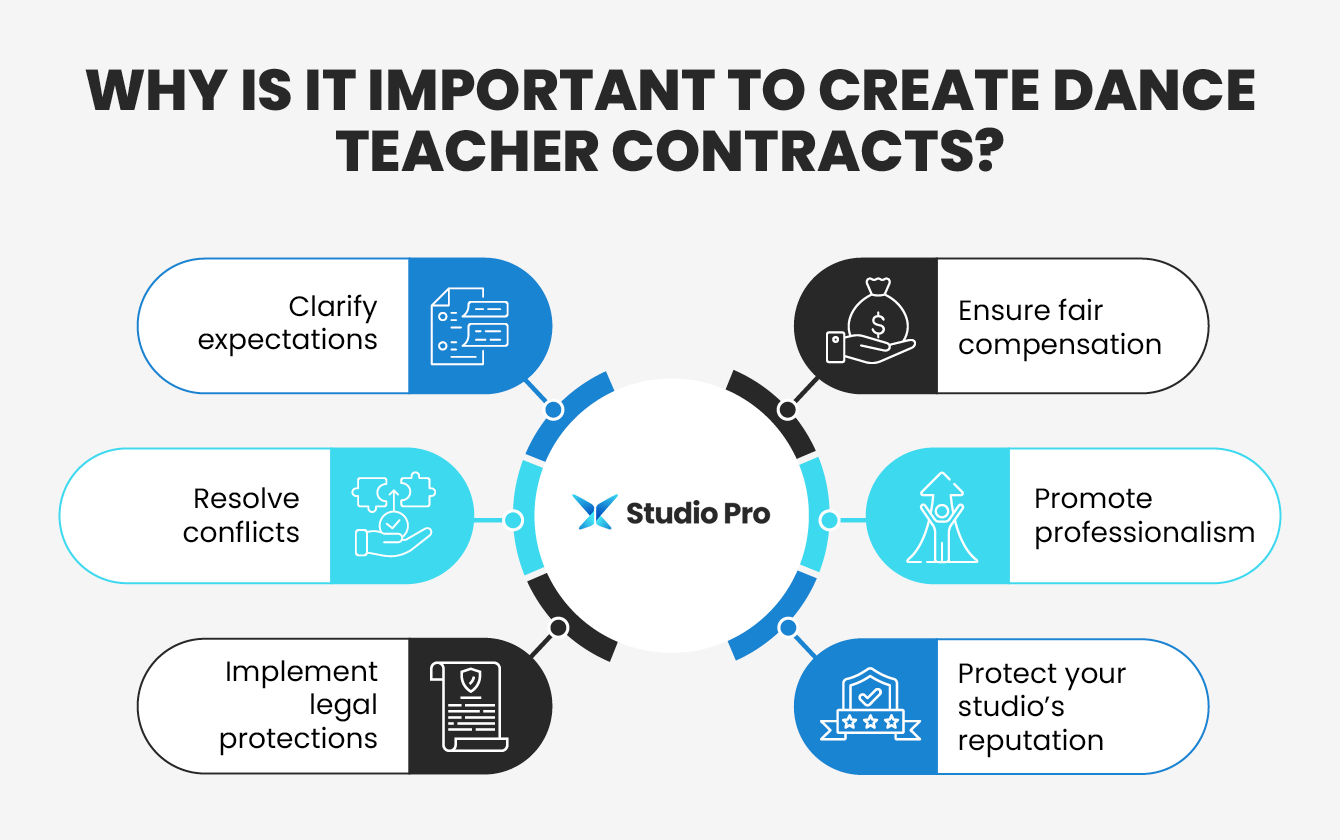
- Clarify expectations. A contract provides a framework for your studio and the new teacher to align expectations. When your working agreement is in writing, you can prevent misunderstandings and ensure employees understand their responsibilities from the start.
- Resolve conflicts. Having agreed-upon strategies for handling disagreements and clear rules surrounding your studio’s operations allows you to resolve conflicts more easily. Your dance teacher contract is a source of truth that both parties can refer back to if they feel the other party has breached the agreement’s terms.
- Implement legal protections. With a formalized employment agreement, you can ensure compliance with labor laws and tax obligations. Additionally, your dance teacher contract should include steps for addressing disputes, protecting intellectual property, and upholding confidentiality, thereby preventing legal action related to these issues.
- Ensure fair compensation. As the example in the introduction illustrates, clear payment terms are essential to developing strong working relationships. A dance teacher contract allows you to present your compensation plan and enables new hires to understand and (if necessary) negotiate these stipulations.
- Promote professionalism. Your dance teacher contract symbolizes the beginning of a teacher’s tenure at your business. Formalized agreements like this further your studio's professional image and ensure new and potential hires take your business seriously.
- Protect your studio’s reputation. By standardizing conduct expectations, you can ensure teachers represent your studio professionally. Plus, when teachers decide to leave your studio, they can do so amicably, knowing both parties have upheld their sides of the agreement. That way, they can speak about their experience at your business in a positive light with other members of the dance community.
Dance teacher contracts protect your business and new hires, ensuring a strong, mutually beneficial foundation for your working relationships.
What Elements Should a Dance Teacher Contract Include?
Include the following elements in your dance teacher contract:
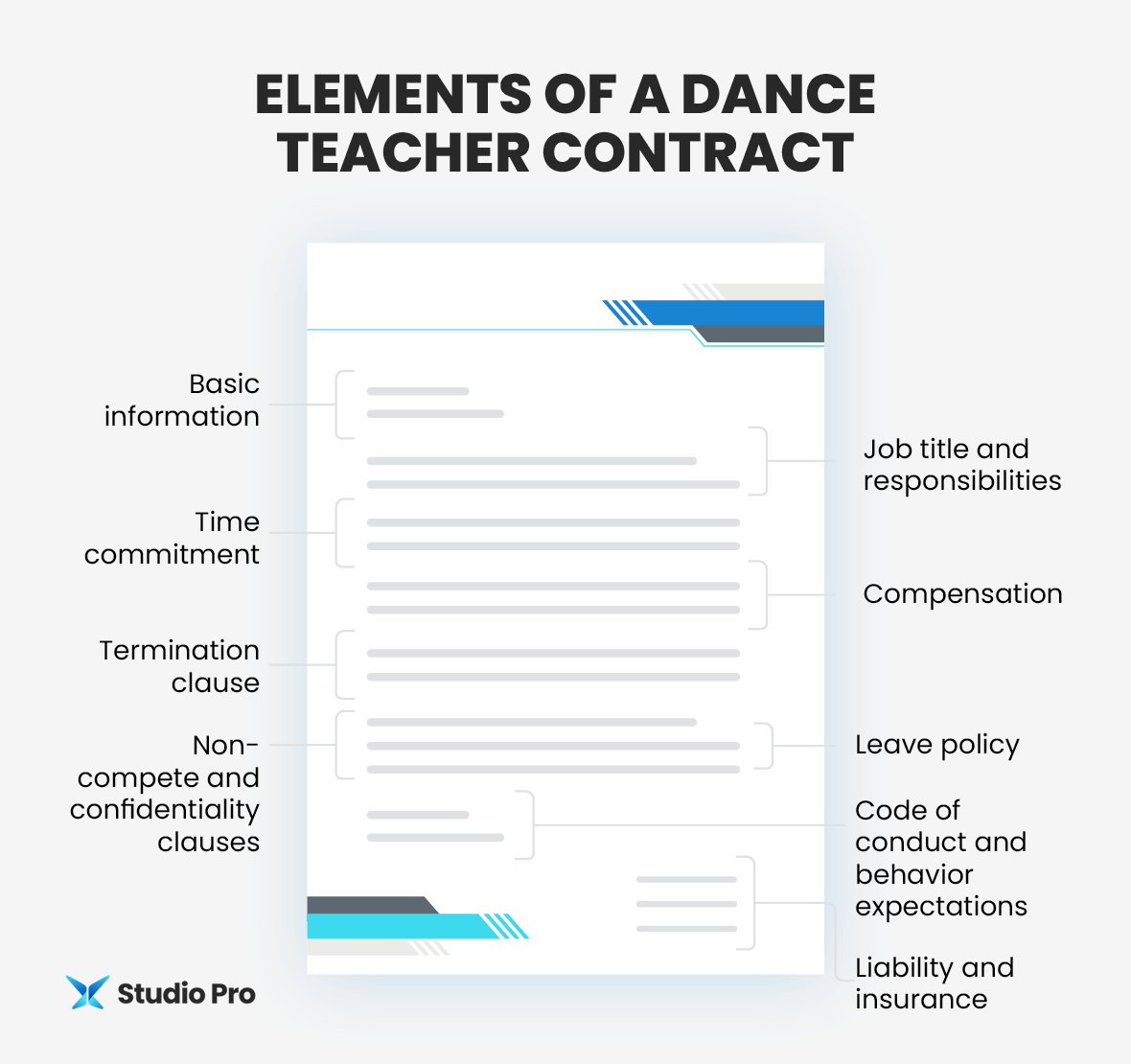
Basic Information
Ensure your contact features basic information like:
- Names of both parties. Clarify the names of your studio (the employer) and dance teacher (the employee) within the agreement.
- Start date and term of the agreement. State when the contract starts and its duration. For example, you might have a one-year contract for a special choreographer or a seasonal contract based on your competition team’s dance season.
- Employment status. Establish whether your teacher is an independent contractor or employee. Depending on their employment status, they’ll have different tax implications, benefits, and legal rights.
Job Title and Responsibilities
Your dance studio contract should define your new hire’s role as a teacher and their specific responsibilities. These may include:
- Teaching classes in various styles like ballet, jazz, hip hop, lyrical, acro, and contemporary
- Choreographing routines for recitals, performances, and/or competitions
- Furthering students’ dance skills and knowledge
- Leading rehearsals
- Providing private lessons
Additionally, incorporate any secondary responsibilities, such as attending staff meetings, helping with events, running the studio’s social media presence, tracking student progress, and communicating with parents. Develop and include a communication policy that governs how teachers should interface with parents, students, prospective customers, and fellow teachers.
Time Commitment
New hires should know from the beginning how much time they’re expected to dedicate to your studio. Indicate whether the teacher will be working full-time, part-time, or on a contract basis.
Include your studio’s class schedule, highlighting the classes the new teacher will teach. Tally up the number of hours per week the teacher should expect to work at the studio, including time spent teaching, choreographing, and handling other responsibilities.
Performances, recitals, and competitions may require extra work outside their typical hours. Clarify when these occurrences are, how much additional time they require, and when teachers need to be available.
Compensation
Compensation covers everything related to employee pay, including:
- Pay rate. Include how much you’ll pay the teacher per unit of time. For instance, you may have an hourly rate, pay per class, or salary-based compensation.
- Payment schedule. Establish when you’ll make payments (weekly, bi-weekly, monthly, or otherwise) and how (check, direct deposit, etc.).
- Additional compensation. If you offer any additional compensation like bonuses, competition choreographer pay, private lesson pay, or overtime for helping with special events, note those here.
- Benefits. While it may be unrealistic for small studios to offer employment benefits like health insurance and retirement plans, offering benefits can keep your studio competitive compensation-wise.
- Reimbursement policy. There may be situations where a teacher incurs expenses on your studio’s behalf. For example, a teacher may order class costumes using their personal credit card. Developing a reimbursement policy ensures a clear method for paying employees back.
Consider how you’ll handle one-off expenses for events, competitions, and performances. For example, determine if you’ll pay for teachers to stay onsite the week of your annual summer national competition, reimburse them for some travel expenses, or require them to cover all associated costs.
Termination Clause
Determine how much notice both parties must provide to terminate the contract. A typical notice period can be anywhere from two weeks to a month in advance.
There may be situations in which either party can or must terminate the contract early. Define these conditions, which may include scenarios like:
- Breach of contract
- Lack of performance
- Insubordination or misconduct
- Health issues
- Inability to further perform responsibilities
While rare, certain severe situations, such as theft, illegal activities, or student endangerment, may necessitate immediate termination without notice. Clarify these scenarios and how your studio handles them.
Non-Compete and Confidentiality Clauses
Dance is a competitive industry. Protect your studio by including a non-compete agreement that prevents teachers from teaching at or opening a competing studio within a specific radius and/or for a certain time period after leaving your studio. Also, create a confidentiality clause to ensure teachers keep important studio and student information private.
Leave Policy
Teachers with full employee status may have paid time off (PTO) in the form of sick days, vacation days, and/or holidays. Let them know how many days they have of each type and when they can take them. For example, teachers may be unable to take off the week before a competition.
Additionally, define scenarios in which employees can take extended leave, how they must notify you, and how they should cover their classes during their absence.
Liability and Insurance
Your liability and insurance procedures should cover:
- Injuries. In the dance world, injuries are common. Determine who is responsible for injuries that occur in class or rehearsals and whether your studio provides insurance.
- Insurance requirements. In most cases, teachers who are independent contractors need their own insurance for liability or accidents.
- Intellectual property. Clarify whether your studio or the teacher owns the choreography produced during their time at your studio. Additionally, determine whether your studio can use choreography or educational materials that the teacher created for promotional purposes or future performances.
Code of Conduct and Behavior Expectations
Set expectations for professional conduct. These may include punctuality, dress code, and communication standards.
Additionally, include a section on dispute resolution. A well-written dance teacher contract is an effective tool for conflict prevention and management, so define what constitutes an official dispute and the steps each party should take to resolve it.

Best Practices for Creating a Dance Teacher Contract
In addition to including the elements listed above, follow these best practices to develop an effective dance teacher contract:
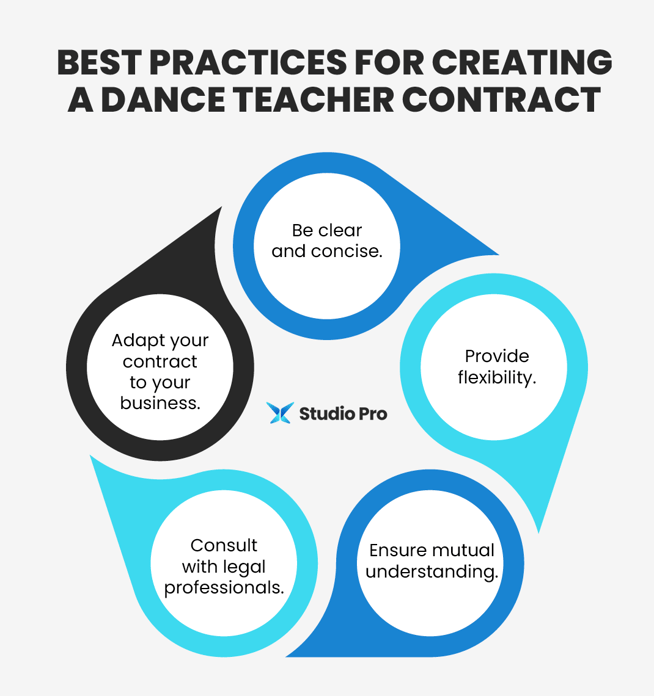
- Be clear and concise. Use straightforward language and define any terms that might cause confusion. For example, you may explain that “Dance the Night!” is the name of your annual recital, and after referring to it by name once, you will hereby refer to it as “recital” within the contract.
- Provide flexibility. While your contract should outline clear rules, there may be exceptions you should account for. Build flexibility into your contracts so you can adjust them for circumstances like illness, emergencies, or growing studio needs.
- Ensure mutual understanding. Proper contracts lead to more positive, long-term relationships with teachers, but only if both parties fully understand the terms. Be open to answering questions before a new teacher signs their contract, and have both parties sign it to indicate mutual agreement.
- Consult with legal professionals. You may not know all the nuances your contract must include to ensure you comply with local employment laws and properly protect your business. Consider working with legal professionals to construct your contract to avoid legal consequences like non-compliance with local labor laws and employee classification rules or violation of intellectual property rights.
- Adapt your contract to your business. No one knows your business like you do. As long as you include all essential information, add or remove clauses as you see fit. For example, suppose your studio has a mentorship program for which employees get extra compensation. In that case, you may explain the program and how employees can opt in within your contract.
Before implementing your contract for the first time, have another staff member review it for typos. That way, you can get another set of eyes on it and ensure it’s fully polished before sending it to a new hire.
Common Dance Teacher Contract Mistakes to Avoid
Set your dance teacher contract up for success by avoiding these common mistakes:
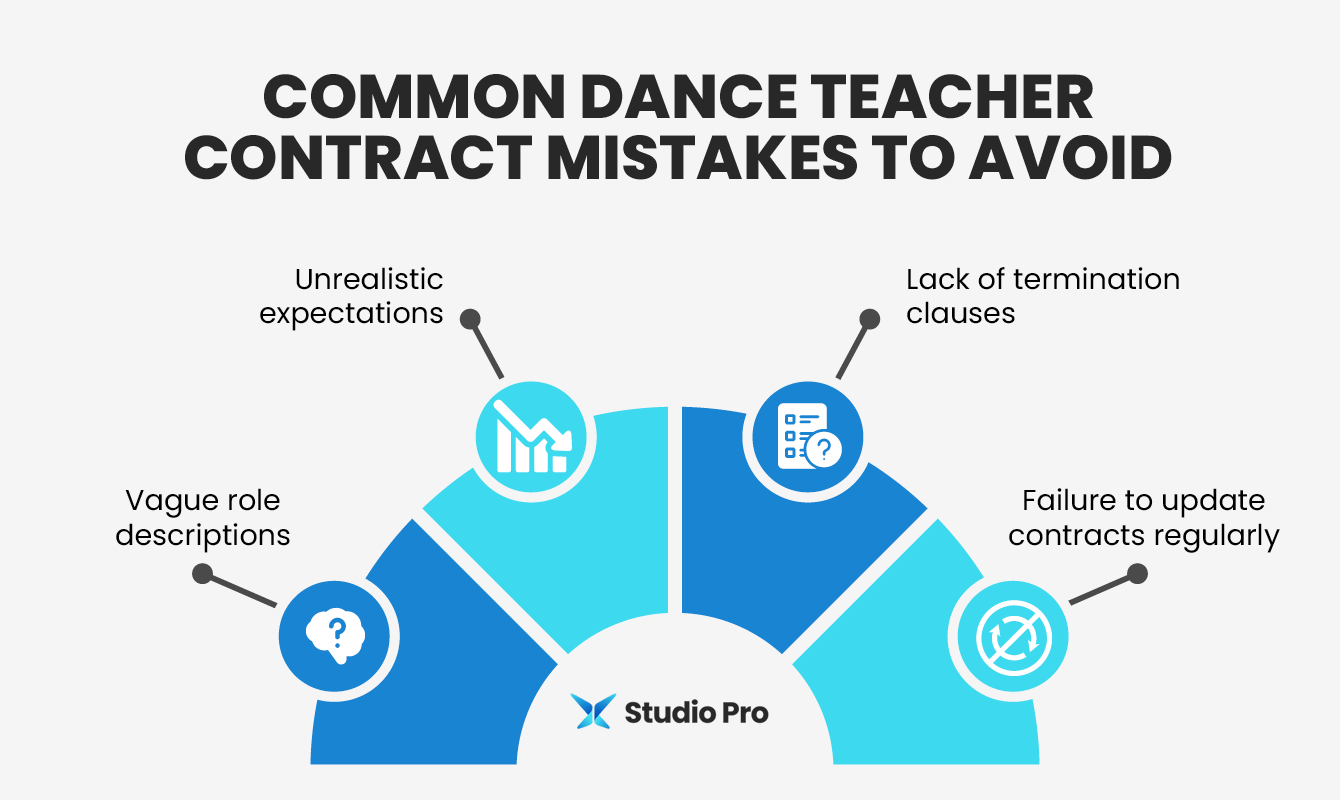
Vague Role Descriptions
Imagine you’re a new teacher at the studio and receive a contract with the following role description:
- Teach classes
- Lead rehearsals
- Attend the recital
- Execute administrative tasks
You’d probably be confused about exactly what you should do and when. Instead, be as specific as possible in your role descriptions. A better role description may look like this:
- Teach two ballet classes per week on Mondays and Wednesdays from 5:30-7 pm and two lyrical classes per week on Mondays and Wednesdays from 7-8:30 pm
- Lead rehearsals for our mini and junior competitive lyrical lines on Thursdays from 5-6 pm and 6-7 pm, respectively
- Choreograph for and attend our annual recital “Dance the Night!” on Sunday, June 8th (additional timing and scheduling details to come)
- Execute administrative tasks, including tracking students’ weekly progress and communicating with parents on an ad hoc basis
Unrealistic Expectations
Chances are, many of your dance teachers work at the studio part-time, meaning they likely have other responsibilities and won’t be available to respond to communications or be at the studio around the clock.
When developing your role descriptions, time commitment, termination clause, and code of conduct, determine what is reasonable to expect from a new hire. Discuss with your current staff how much time they spend on certain tasks so you can better understand what you should expect and present within your contracts.
Lack of Termination Clauses
While you should be optimistic about new hires, anything could happen. Without clear termination clauses, you may incite disputes about when and how either party can end the contract. To avoid conflict, ensure all contracts have termination clauses and that new hires explicitly consent to this policy.
Failure to Update Contracts Regularly
When you run a dance studio, change is imminent. Whether you’re facing changes to labor laws, studio policies, or employment conditions, you must update contracts regularly to ensure they’re compliant.
For example, if you created a new policy outlining rules for studio rentals and drop-in sessions, add a relevant clause to your contract covering teachers’ roles in upholding this policy.
Dance Teacher Contract Sample
Below is a dance teacher contract sample that follows the tips we’ve covered above:
 Adapt this template to fit your studio’s needs before integrating it into the hiring process.
Adapt this template to fit your studio’s needs before integrating it into the hiring process.
Manage Teacher Relationships with Studio Pro
A proper dance teacher contract is the key to successful working relationships, allowing you to clarify your expectations for teachers, resolve disputes, and protect both parties. By creating these contracts and updating them over time, you can promote professionalism across your business and better retain staff members.
Once you’ve onboarded new teachers, Studio Pro helps you manage these relationships, empowering you to:
- Assign classes to different teachers
- Log and share teacher notes
- Communicate with teachers
If you’re ready to supercharge your dance teacher relationships and leverage the best dance studio software on the market, sign up for a free 30-day trial
to get started! For more helpful dance studio owner resources, check out these articles:

Laura Cole, CEO and Business Leader of Studio Pro

Laura Cole is the CEO and Business Leader of Studio Pro, a leading studio management software platform serving over 6,000 studios across all 50 U.S. states and more than 35 countries. Laura brings deep expertise in SaaS operations, strategic planning, and project management, with a passion for helping dance, cheer, gymnastics, and performing arts businesses grow and thrive.
Since taking the helm in 2020, she’s been dedicated to building tools that streamline studio operations and empower small business owners to succeed. When she’s not leading Studio Pro or partnering with studio owners, Laura enjoys running, yoga, and hosting friends at home with her husband and two young boys.

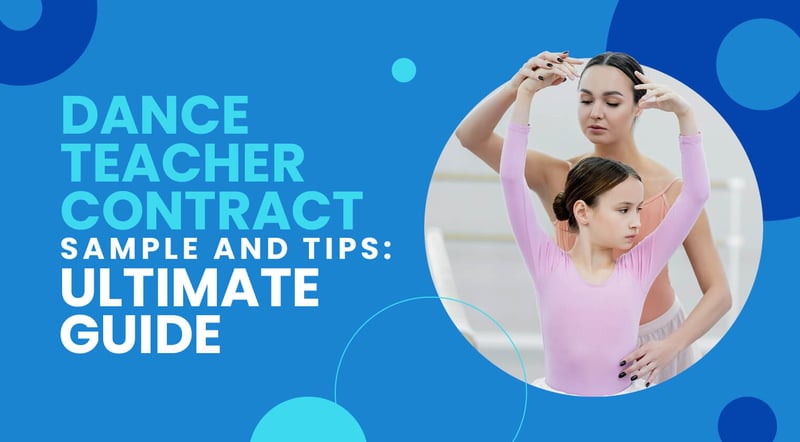







 Adapt this template to fit your studio’s needs before integrating it into the hiring process.
Adapt this template to fit your studio’s needs before integrating it into the hiring process.



_The%20Ultimate%20Self-Care%20Guide%20for%20Dance%20Teachers_Feature.jpg?width=596&name=DanceStudio-Pro_Different%20Drummer%20Dance%20(GAP)_The%20Ultimate%20Self-Care%20Guide%20for%20Dance%20Teachers_Feature.jpg)
